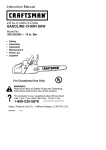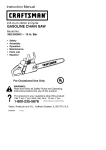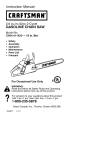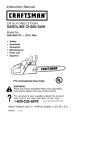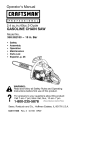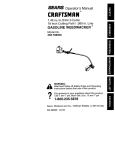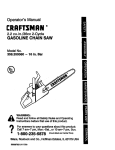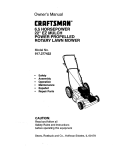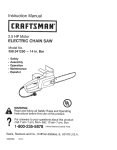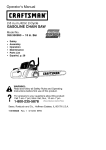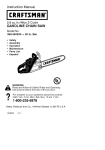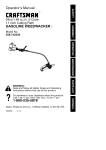Download Craftsman 358.350201 Instruction manual
Transcript
Instruction
Manual
I CRRFTSMRN°I
2.8 cu.in./46cc 2-Cycle
GASOLINE CHAIN SAW
Model No.
358.350201
•
- 20 In. Bar
Safety
• Assembly
• Operation
• Maintenance
•
Parts
List
•
EspaSol
WARNING:
@
Read and follow all Safety Rules and Operating
Instructions
before first use of this product.
For answers
Call 7 am-7
to your questions about this product:
pm, Mon-Sat; Sun, 10 am-7 pm
1-800-235-5878
Sears,
530088324
Roebuck
12/12/01
and Co., Hoffman
Estates,
IL 60179 U.S.A.
Warranty
Safety Rules
Assembly
Operation
Maintenance
Service and Adjustments
2
2
6
7
13
17
FULL ONE YEAR WARRANTY
Storage
Troubleshooting
Table
Emissions Statement
Parts List
Spanish
Parts & Ordering
ON CRAFTSMAN
19
20
21
23
26
Back Cover
_ GAS CHAIN SAW
For one year from the date of purchase, when this Craftsman Gas Chain Saw is
maintained, lubricated, and tuned-up according to the instruction manual, Sears
will repair, free of charge, any defect in material or workmanship.
This warranty does not include the bar, chain, spark plug, and air filter, which are
expendable parts and become worn during normal use.
If this Gas Chain Saw is used for commercial or rental purposes, this warranty
applies for only 30 days from the date of purchase.
WARRANTY SERVICE IS AVAILABLE BY RETURNING THIS CHAIN SAW TO THE
NEAREST SEARS STORE OR SERVICE CENTER IN THE UNITED STATES.
This warranty gives you specific legal rights, and you may also have other rights
which vary from state to state.
Sears, Roebuck and Co., D/817 WA, Hoffman Estates, IL 60179
WARNING:
Always disconnect
spark plug wire when making repairs
except for carburetor adjustments. Because a chain saw is a high-speed
woodcutting tool, special precautions
must be observed to reduce risk of accidents. Careless or improper use of
this tool can cause serious injury.
PLAN AHEAD
• Restrict the use of your saw to adult
users who understand and can follow the safety rules, precautions,
and operating instructions found in
this manual.
Hearing
Protection
"-_.
Snug
Fitting ......._
Clothing
Safety Hat
,_,"_ ...... Eye
iM
i.,_....
Protection
Heavy Duty
Gloves
./
Safety
Shoes
j
Safety Chaps
\\
a4_
• Wear protective gear. Always use
steel-toed safety footwear with nonslip soles; snug-fitting clothing;
heavy-duty, non-slip gloves; eye protection such as non-fogging, vented
goggles or face screen; an approved
safety hard hat; and sound barriers
(ear plugs or mufflers) to protect your
hearing. Regular users should have
hearing checked regularly as chain
saw noise can damage hearing.
• Secure hair above shoulder length. Do
not wear loose clothing or jewelry; they
can get caught in moving parts.
• Keep all parts of your body away
from the chain when the engine is
running.
• Keep children, bystanders, and animals at least 30 feet (10 meters) away
from work area when starting or using
saw.
• Do not handle or operate a chain saw
when you are fatigued, ill, or upset, or
if you have taken alcohol, drugs, or
medication. You must be in good
physical condition and mentally alert. If
you have any condition that might be
aggravated by strenuous work, check
with doctor before operating.
• Do not start cutting until you have a
clear work area, secure footing, and
especially if you are felling a tree, a
retreat path.
OPERATE
YOUR
SAW
SAFELY
• Donotoperate
withonehand.
Seriousinjury
totheoperator,
helpers,
or
bystanders
mayresult
fromonehanded
operation.
Achainsawisintended
fortwo-handed
use.
• Operate
thechain
sawonlyinawell
ventilated
outdoor
area.
• Donotoperate
sawfromaladder
or
inatree.
• Make
surethechain
willnotmake
contact
withanyobject
whilestarting
theengine. Never try to start the saw
when the guide bar is in a cut.
• Do not put pressure on the saw at
the end of the cut. Applying pressure
can cause you to lose control when
the cut is completed.
• Stop engine before setting saw down.
• Hand carry saw only when engine is
stopped. Carry with muffler away
from body; guide bar and chain projecting behind you; guide bar preferably covered with a scabbard.
• Do not operate a chain saw that is
damaged, improperly adjusted, or not
completely and securely assembled.
Always replace bar, chain, hand
guard, chain brake, or other parts immediately if they become damaged,
broken, or are otherwise removed.
MAINTAIN
YOUR
SAW IN GOOD
WORKING ORDER
• Have all chain saw service performed by a qualified service dealer
except the items listed in the MAINTENANCE section of this manual
• Make certain the saw chain stops
moving when the throttle trigger is
released. For correction, refer to
CARBURETOR ADJUSTMENTS.
• Keep the handles dry, clean, and
free from oil or fuel mixture.
• Keep caps and fasteners securely
tightened.
• Nonconforming replacement components or the removal of safety devices
may cause damage to the unit and
possible injury to the operator or bystanders. Use only Craftsman accessories and replacement parts as recommended. Never modify your saw.
• Maintain chain saw with care.
• Keep unit sharp and clean for better
and safer performance.
• Follow instructions for lubricating and
changing accessories.
• Check for damaged parts. Before further use of the chain saw, a guard or
other part that is damaged should be
carefully checked to determine that it
will operate properly and perform its
intended function. Check for alignment
of moving parts, binding of moving
parts, breakage of parts, mounting and
any other conditions that may affect its
operation. A guard or other part that is
damaged should be properly repaired
or replaced by a Sears Service Center
unless otherwise indicated elsewhere
in the instruction manual.
• When not in use, chain saws should
be stored in a dry, high or locked-up
place out of the reach of children.
• When storing saw, use a scabbard or
carrying case.
HANDLE FUEL WITH CAUTION
• Do not smoke while handling fuel or
while operating the saw.
• Eliminate all sources of sparks or
flame in the areas where fuel is
mixed or poured.
• Mix and pour fuel in an outdoor area
and use an approved, marked container for all fuel purposes. Wipe up
all fuel spills before starting saw.
• Move at least 10 feet (3 meters) from
fueling site before starting.
• Turn the engine off and let saw cool
in a non-combustible
area, not on
dry leaves, straw, paper, etc. Slowly
remove fuel cap and refuel unit.
• Store the unit and fuel in a cool, dry
well ventilated space where fuel vapors cannot reach sparks or open
flames from water heaters, electric
motors or switches, furnaces, etc.
GUARD AGAINST KICKBACK
Follow all safety rules to help avoid
kickback and other forces which can
result in serious injury.
"2
__
Kickback Path
/1
Avoid Obstructions
Clear The Working Area
increase the chance of kickback.
Follow manufacturer's
chain sharpening and maintenance instructions.
Check tension at regular intervals,
but never with engine running. Make
sure bar clamp nuts are securely
tightened.
• Begin and continue cutting at full
speed. If the chain is moving at a
slower speed, there is greater
chance of kickback occurring.
• Use extreme caution when re-entering a cut.
• Do not attempt cuts starting with the
tip of the bar (plunge cuts).
• Watch for shifting logs or other forces
that could close a cut and pinch or
fall into chain.
• Use the specified Reduced-Kickback
Guide Bar and Low Kickback Chain.
Avoid Pinch-Kickback:
• Be extremely aware of situations or
obstructions that can cause material
to pinch the top of or otherwise stop
the chain.
• Do not cut more than one log at a
time.
• Do not twist the saw as the bar is
withdrawn from an undercut when
bucking.
Avoid Pull-In:
• Always begin cutting with the engine
at full speed and the saw housing
against wood.
• Use wedges made of plastic or
wood. Never use metal to hold the
cut open.
MAINTAIN CONTROL
Stand to the left of the saw
Z_
WARNING:
Avoid kickback which
can result in serious injury. Kickback
is the backward, upward or sudden forward motion of the guide bar occurring
when the saw chain near the upper tip
of the guide bar contacts any object
such as a log or branch, or when the
wood closes in and pinches the saw
chain in the cut. Contacting a foreign
object in the wood can also result in
loss of chain saw control.
• Rotational Kickback
can occur
when the moving chain contacts an
object at the upper tip of the guide
bar. This contact can cause the
chain to dig into the object, which
stops the chain for an instant. The
result is a lightning fast, reverse
reaction which kicks the guide bar up
and back toward the operator.
• Pinch-Kickback
can occur when the
the wood closes in and pinches the
moving saw chain in the cut along
the top of the guide bar and the saw
chain is suddenly stopped. This sudden stopping of the chain results in a
reversal of the chain force used to
cut wood and causes the saw to
move in the opposite direction of the
chain rotation. The saw is driven
straight back toward the operator.
• Pull-In can occur when the moving
chain contacts a foreign object in the
wood in the cut along the bottom of
the guide bar and the saw chain is
suddenly stopped. This sudden stopping pulls the saw forward and away
from the operator and could easily
cause the operator to lose control of
the saw.
underside
of handlebar
Thumb on
REDUCE THE CHANCE OF
KICKBACK
• Recognize that kickback can happen.
With a basic understanding of kickback, you can reduce the element of
surprise which contributes to accidents.
• Never let the moving chain contact
any object at the tip of the guide bar.
• Keep working area free from obstructions such as other trees, branches,
rocks, fences, stumps, etc. Eliminate
or avoid any obstruction that your
saw chain could hit while cutting.
• When cutting a branch, do not let the
guide bar contact another branch or
other objects around it.
• Keep saw chain sharp and properly
tensioned. A loose or dull chain can
\[
_ j
:_jj_
Elbow
locked
Never reverse hand positions
• A good, firm grip on the saw with
both hands will help you maintain
control. Don't let go. Grip the rear
handle with your right hand whether
you are right or left handed. Wrap the
fingers of your left hand over and
around the front handlebar, and your
left thumb under the front handlebar.
Keep your left arm straight with the
elbow locked.
• Position your left hand on the front
handlebar so it is in a straight line
4
withyourrighthandontherearhandlewhenmaking
bucking
cuts.
Stand
slightly
totheleftsideofthe
sawtokeepyourbody
frombeing
in
adirect
linewiththecutting
chain.
• Stand
withyourweight
evenly
balanced
onbothfeet.
• Donotoverreach.
Youcouldbe
drawn
orthrown
offbalance
andlose
control.
• Donot
cut
above
shoulder
height.
It
isdifficult
tomaintain
control
ofsaw
above
shoulder
height.
KICKBACK
SAFETY
FEATURES
,_
WARNING:
The following fea-
tures are included on your saw to help
reduce hazard of kickback; however,
such features will not totally eliminate
this danger. Do not rely only on safety
devices. Follow all safety rules to help
avoid kickback and other forces which
can result in serious injury.
• Front Hand Guard: designed to reduce the chance of your left hand
contacting the chain if your hand
slips off the front handlebar.
• Position of front and rear handlebars,
designed with distance between
handles and "in-line" with each other.
The spread and "in-line" position of
the hands provided by this design
work together to give balance and
resistance in controlling the pivot of
the saw back toward the operator if
kickback occurs.
• Reduced-Kickback
Guide Bar, designed with a small radius tip which
reduces the size of the kickback
danger zone on the bar tip. This type
bar has been demonstrated to significantly reduce the number and seriousness of kickbacks when tested in
accordance with ANSI B175.1.
_',_e
L_._._
Large Radius
Guide
Bar
Small Radius Tip
Guide Bar
Tip [
_,_
• Low Kickback Chain, has met kickback performance requirements
when tested on a representative
sample of chain saws below 3.8 cu-
bic inch displacement
ANSI B175.1.
Low-Kickback Chain
specified
in
......... Contoured Depth Gauge
deflects kickback force
and
allows Guard
wood to
Elongated
Link
gradually ride into Cutter
CHAIN BRAKE
• Chain Brake: designed to stop the
chain in the event of kickback.
m_WARNINu:
WE DO NOT REPRESENT AND YOU SHOULD NOT ASSUME THAT THE CHAIN BRAKE WILL
PROTECT YOU IN THE EVENT OF A
KICKBACK. Kickback is a lightning fast
action which throws the bar and rotating chain back and up toward the operator. Kickback can be caused by allowing contact of the bar tip in the
danger zone with any hard object.
Kickback can also be caused by
pinching the saw chain along the top
of the guide bar. This action may push
the guide bar rapidly back toward the
operator. Either of these events may
cause you to lose control of the saw
which could result in serious injury or
even death. DO NOT RELY UPON ANY
OF THE DEVICES BUILT INTO YOUR
SAW. YOU SHOULD USE THE SAW
PROPERLY AND CAREFULLY TO AVOID
KICKBACK. Reduced-kickback
guide
bars and low-kickback
saw chains reduce the chance and magnitude of
kickback and are recommended.
Your
saw has a low kickback chain and bar
as original equipment.
Repairs on a
chain brake should be made by an authorized Sears Service Center. Take
your unit to the place of purchase or to
your nearest Sears Service Center.
• Tip contact in some cases may cause
a lightning fast reverse REACTION,
kicking guide bar up and back toward
operator.
• Pinching the saw chain along the top
of the guide bar may push the guide
bar rapidly back toward the operator.
• Either of these reactions may cause
you to lose control of the saw which
could result in serious injury. Do not
rely exclusively upon safety devices
built into your saw.
ARRESTING
SCREEN:
Your
SAFETY
NOTICE:
Exposure
tovibra- SPARK
tionsthrough
prolonged
useofgaso- sawisequipped
withatemperature
limlinepowered
hand
toolscould
cause iting
muffler
andspark
arresting
screen
blood
vessel
ornerve
damage
inthe
meets
therequirements
ofCaliforfingers,
hands,
andjoints
ofpeople which
niaCodes
4442and4443.
AllU.S.
forprone
tocirculation
disorders
or
est
l
and
a
nd
the
states
ofCalifornia,
Idaabnormal
swelling.
Prolonged
usein
ho,
M
aine,
Minnesota,
New
Jersey,
coldweather
hasbeenlinked
toblood Oregon,
andWashington
require
bylaw
vessel
damage
inotherwise
healthy that
many
internal
combustion
engines
people.
Ifsymptoms
occur
suchas
beequipped
withaspark
arresting
numbness,
pain,
lossofstrength,
Ifyouoperate
achain
sawina
change
inskincolor
ortexture,
orloss screen.
state
orlocale
where
suchregulations
offeeling
inthefingers,
hands,
or
youarelegally
responsible
for
joints,
discontinue
theuseofthistool exist,
andseekmedical
attention.
Ananti-vi- maintaining
theoperating
condition
of
parts.
Failure
todosoisaviolabration
system
does
notguarantee
the these
toCustomer
Reavoidance
ofthese
problems.
Users tionofthelaw.Refer
chart
intheMAINTENANCE
whooperate
power
toolsonacontinu- sponsibilities
section.
alandregular
basis
must
closely
monitor
theirphysical
condition
and
STANDARDS:
Thischainsawislisted
thecondition
ofthistool.
byUnderwriters
Laboratories,
Inc.in
CHAIN
BRAKE:
Ifthissawistobe
accordance
withAmerican
National
used
forcommercial
logging,
achain Standards
forGasoline-Powered
brake
isrequired
andshallnotbere- Chain
S
aws
Safety
Requirements
moved
orotherwise
disabled
tocom- (ANSI
B175.1-2000).
plywithFederal
OSHA
Regulations
for
Commercial
Logging.
WARNING:
Before
using
chain
saw,ensure
allfasteners
aresecure.
CARTON
CONTENTS
Check
carton
contents
against
thefollowing
list.
Model 358,350201
• Chain Saw (fully assembled)
• Bar tool
• 2-cycle engine oil
• Carrying case
Examine parts for damage.
damaged parts.
Do not use
If you need assistance or find parts
missing or damaged, please call
1-800-235-5878.
NOTE: It is normal to hear the fuel filter
rattle in an empty fuel tank.
Your unit has been factory tested and
the carburetor precisely adjusted. As a
result you may smell gasoline or find a
drop of oil/fuel residue on the muffler
when you unpack the unit.
ASSEMBLY
Your saw is fully assembled; no assembly is necessary.
KNOW
YOUR
SAW
READ THIS INSTRUCTION MANUAL AND SAFETY RULES BEFORE OPERATING YOUR
CHAIN SAW. Compare the illustrations with your unit to familiarize yourself with the
location of the various controls and adjustments. Save this manual for future reference.
Chain Adjustment
Tool
(Bar Tool)
Front Hand Guard
Muffler
Front Handle
/
Starter Rope
/
/
ON/STOP
,/ Switch
/
Chain
Bar Sprocket
Hole
Bar Oil
Fill Cap
Fuel Mix Fill Cap
Starter Housing
Cylinder Cover
Throttle
Lock-out
Rear
Handle
Adjusting
'\\
Direction
of Chain
Travel
_
Screw
Throttle
Trigger
Guide Bar
/
l/
Chain Brake
Chain Brake Nuts
Choke/Fast
Idle Lever
ON/STOP SWITCH
The ON/STOP SWITCH is used to stop
the engine.
THROTTLE TRIGGER
The THROTTLE TRIGGER controls engine speed.
THROTTLE
LOCK-OUT
The THROTTLE LOCK-OUT must be
pressed before you can squeeze the
throttle trigger. This feature prevents
you from accidentally squeezing the
trigger.
CHOKE/FAST
IDLE LEVER
The choke and fast idle speed are set
by pulling the CHOKE/FAST IDLE LEVER
out fully for cold or for refueled starting.
The choke provides additional fuel to
the engine during cold starting.
CHAIN BRAKE
The CHAIN BRAKE is a device designed to stop the chain if kickback occurs. The chain brake activates automatically in the event of kickback. The
chain brake activates manually if the
front hand guard is pushed forward.
The chain brake is disengaged by pulling the front hand guard back toward
the front handle as far as possible.
CHAIN TENSION
It is normal for a new chain to stretch
during first 30 minutes of operation.
You should check your chain tension
frequently. See CHAIN TENSION in the
SERVICE AND ADJUSTMENTS section.
_WARNIN_I:
Muffler is very hot
during and after use. Do not touch the
muffler or allow combustible material
such as dry grass or fuel to do so.
BEFORE
STARTING
ENGINE
IMPORTANT
Experience
indicates
thatalcohol
blended
fuels(called
gasohol
orusing
_WARNING:Besuretoread
the
ormethanol)
canattract
moisfuelhandling
information
inthesafety ethanol
leads
toseparation
and
rules
section
ofthismanual
before
you turewhich
formation
ofacids
during
storage.
Acidic
begin.
Ifyoudonotunderstand
the
gascandamage
thefuelsystem
ofan
fuelhandling
information
donotatengine
while
instorage.
tempt
tofuelyourunit.Seek
helpfrom Toavoid
engine
problems,
thefuelsyssomeone
thatdoesunderstand
theinbeemptied
before
storage
formation
orcallthecustomer
assis- temshould
Drain
thegas
tance
helplineat1-800-235-5878. for30daysorlonger.
tank,
start
theengine
andletitrununtil
GUIDE
BARANDCHAIN
OIL
fuellinesandcarburetor
areempty.
Thebarandchain
require
lubrication. the
Usefresh
fuelnextseason.
SeeSTORThechain
oilerprovides
continuous AGE
instructions
foradditional
informalubrication
tothechainandguide
bar. tion.Never
use
engine
orcarburetor
Besuretofillthebaroiltankwhen
you
products
inthefueltankorperfillthefueltank(Capacity
=6.8fl.oz.). cleaner
damage
mayoccur.
Lack
ofoilwillquickly
ruinthebarand manent
theSTORAGE
section
foradditional
chain.Toolittleoilwillcause
overheat-See
information.
ingshown
bysmoke
coming
fromthe
BRAKE
chain
and/or
discoloration
ofthebar. CHAIN
chainbrake
isdisengaged
by
Formaximum
guide
barandchain
life, Ensure
thefronthand
guard
backtowerecommend
youuseCraftsman pulling
ward
thefronthandle
asfarasposchain
sawbaroil.IfCraftsman
baroil
Thechainbrake
must
bedisenisnotavailable,
youmayuseagood sible.
gaged
before
cutting
with
the
saw.
grade
SAE30oiluntilyouareableto
obtain
Craftsman
brand.
Theoiloutput ,_WARNING:
The chain must not
isautomatically
metered
during
operation.Your
sawwilluseapproximatelymove when the engine runs at idle
If the chain moves at idle
onetankofbaroilforevery
tankoffuel speed.
refer to CARBURETOR ADJUSTmix.Always
fillbaroiltankwhen
you speed,
MENT within this manual. Avoid confillthefueltank.
tact with the muffler. A hot muffler can
FUELING
ENGINE
cause serious burns.
STOPPING
YOUR
ENGINE
_WARNIN_I:Remove
fuelcap
• Move ON/STOP switch to the STOP
slowly
whenrefueling.
position.
Thisengine
iscertified
tooperate
onun- STARTING
POSITION
leaded
gasoline.
Before
operation,
gaso- To start the engine,
hold the saw firmly
linemust
bemixed
withagood
quality on the ground as illustrated
below.
synthetic
2-cycle
air-cooled
engine
oil.
sure the chain is free to turn
Werecommend
Craftsman
brand
syn- Make
thetic
oil.Mixgasoline
andoilataratio without contacting any object.
of40:1.A40:1ratioisobtained
bymixStarter Rope Handle
ing3.2ounces
ofoilwith1gallon
ofunii..
leaded
gasoline.
Included
withthissaw
[_'_
_1
_,
Left Hand
isa3.2ounce
container
ofoil.Pour
the
entire
contents
ofthiscontainer
into1
IA_,__'I_ .I I
onFront
gallon
ofgasoline
toachieve
theproper
fuelmixture.
DONOT
USE
automotive
oilorboatoil.
These
oilswillcause
engine
damage.
When
mixing
fuelfollow
theinstructionsprinted
ontheoilcontainer.
Right Foot Through Rear Handle
Onceoilisadded
tothegasoline,
shake
container
momentarily
toassure IMPORTANT POINTS TO REMEMBER
thatthefuelisthoroughly
mixed.
AlWhen pulling the starter rope, do not
waysreadandfollow
thesafety
rules use the full extent of the rope as this can
relating
tofuelbefore
fueling
yourunit. cause the rope to break. Do not let
8
starter
rope
snap
back.Hold
thehandle CHOKE position). This will set the
fast idle lock to the start position.
andlettherope
rewind
slowly.
Forcoldweather
starting,
start
theunit 3. Pull the starter rope quickly with your
right hand until the engine starts.
atFULL
CHOKE;
allow
theengine
to
and release the throttle
warm
upbefore
squeezing
thethrottle 4. Squeeze
trigger to allow engine to return to
trigger.
idle speed.
NOTE:
Donotcutmaterial
withthe
DIFFICULT STARTING (or starting a
choke/fast
idlelever
attheFULL
flooded engine)
CHOKE
position.
The engine may be flooded if it has not
STARTING
A COLD ENGINE (or a
started after 10 pulls.
warm engine after running out of
fuel)
NOTE: In the following steps, when
the choke/fast idle lever is pulled out to
the full extent, the correct throttle setting for starting is set automatically.
1. Move ON/STOP switch to the ON
position.
2. Pull the choke/fast idle lever out to
the full extent.
3. Pull starter rope quickly with your
right hand a maximum of 10 times.
Then, proceed to the next step.
NOTE: If the engine sounds as if it is
trying to start before the 10th pull, stop
pulling and immediately proceed to the
next step.
4. Push the choke/fast idle lever in
completely (to the OFF CHOKE
position).
5. Pull the starter rope quickly with your
right hand until the engine starts.
6. Allow the engine to run for approximately 5 seconds. Then, squeeze
and release throttle trigger to allow
engine to return to idle speed.
Choke/Fast Idle Lever
Flooded engines can be cleared of excess fuel by following the warm engine
starting procedure listed above. Insure
the ON/STOP switch is in the ON position.
Starting could require many pulls depending on how badly unit is flooded. If
engine still fails to start, refer to TROUBLESHOOTING TABLE or call
1-800-235-5878.
CHAIN BRAKE
z't
WAR NI N G: If the brake band is
worn too thin it may break when the
chain brake is triggered. With a broken
brake band, the chain brake will not stop
the chain. The chain brake must be replaced if any part is worn to less than
1/32" thick. Repairs on a chain brake
should be made by your Sears Service
Center. Take your unit to the place of
purchase or to the nearest Sears Service Center.
• This saw is equipped with a chain
brake. The brake is designed to stop
the chain if kickback occurs.
• The inertia-activated
chain brake is
activated if the front hand guard is
pushed forward, either manually (by
hand) or automatically (by sudden
movement).
• If the brake is already activated, it is
disengaged by pulling the front hand
guard back toward the front handle
as far as possible.
• When cutting with the saw, the chain
brake must be disengaged.
Disengaged
STARTING A WARM ENGINE
1. Move ON/STOP switch to the ON
position.
2. Pull the choke/fast idle lever out to
the full extent; then, push the lever
back in completely (to the OFF
Braking function control
CAUTION:
The chain brake must be
checked several times daily. The engine must be running when performing
this procedure.
This is the only
instance
when
thesawshould
be
placed
ontheground
withtheengine
running.
Place
thesawonfirmground.
Gripthe
rearhandle
withyourrighthand
and
thefronthandle
withyourlefthand.
Apply
fullthrottle
byfulldepressing
the
throttle
trigger.
Activate
thechain
brake
byturning
yourleftwristagainst
the
hand
guard
without
releasing
yourgrip
around
thefronthandle.
Thechain
should
stopimmediately.
Inertia
activating
function
control
_,WARNING:
When performing the
following procedure, the engine must
be turned off.
Grip the rear handle with your right
hand and the front handle with your left
hand. Hold the chain saw approximately 14" (35 cm) above a stump or
other wooden surface. Release your
grip on the front handle and use the
weight of the saw to let the tip of the
guide bar fall forward and contact the
stump. When the tip of the bar hits the
stump, the brake should activate.
OPERATING TIPS
• Check chain tension before first use
and after 1 minute of operation. See
CHAIN TENSION in the MAINTENANCE
section.
• Cut wood only. Do not cut metal,
plastics, masonry, non-wood building
materials, etc.
• Stop the saw if the chain strikes a
foreign object. Inspect the saw and
repair parts as necessary.
• Keep the chain out of dirt and sand.
Even a small amount of dirt will
quickly dull a chain and increase the
possibility of kickback.
• Practice cutting a few small logs using
the following steps. This will help you
get the '_feer' of using your saw before
you begin a major sawing operation.
• Squeeze the throttle trigger and allow the engine to reach full speed
before cutting.
• Begin cutting with the saw frame
against the log.
• Keep the engine at full speed the
entire time you are cutting.
• Allow the chain to cut for you. Exert
only light downward pressure.
• Release the throttle trigger as soon
as the cut is completed, allowing
the engine to idle. If you run the
saw at full throttle without a cutting
load, unnecessary wear can occur.
• To avoid losing control when cut is
complete, do not put pressure on
saw at end of cut.
• Stop the engine before setting the
saw down.
TREE
FELLING
TECHNIQUES
_WARNING:
Check for broken or
dead branches which can fall while
cutting causing serious injury. Do not
cut near buildings or electrical wires if
you do not know the direction of tree
fall, nor cut at night since you will not
be able to see well, nor during bad
weather such as rain, snow, or strong
winds, etc.
• Carefully plan your sawing operation
in advance.
• Clear the work area. You need a
clear area all around the tree so you
can have secure footing.
• The chain saw operator should keep
on the uphill side of the terrain as the
tree is likely to roll or slide downhill
after it is felled.
• Study the natural conditions that can
cause the tree to fall in a particular
direction, such conditions include:
• The wind direction and speed.
• The lean ofthe tree. The lean of a
tree might not be apparent due to
uneven or sloping terrain. Use a
plumb or level to determine the direction of tree lean.
• Weight and branches on one side.
• Surrounding trees and obstacles.
• Look for decay and rot. If the trunk is
rotted, it can snap and fall toward the
operator.
• Make sure there is enough room for
the tree to fall. Maintain a distance of
2-1/2 tree lengths from the nearest
person or other objects. Engine
noise can drown out a warning call.
• Remove dirt, stones, loose bark,
nails, staples, and wire from the tree
where cuts are to be made.
q_,
I'
_L,_"_-
45" /_.
lO
Plan a clear retreat path
Direction of fall
FELLING
LARGE
TREES
• Be alert of signs that the tree is
(6inches
indiameter
orlarger)
ready to fall: cracking sounds, widenThenotch
method
isusedtofelllarge ing of the felling cut, or movement in
trees.
Anotch
iscutonthesideofthe
the upper branches.
treeinthedesired
direction
offall.After • As tree starts to fall, stop saw, put it
afelling
cutismade
ontheopposite down, and get away quickly on your
sideoftree,
thetreeshould
fallinthe
planned retreat path.
direction
ofthenotch.
• DO NOT use your saw to cut down a
partially fallen tree. Be extremely
NOTE:
Ifthetreehaslargebuttress
roots,
remove
thembefore
making
the
cautious with partially fallen trees
notch.
Ifusing
sawtoremove
buttress that may be poorly supported. When
roots,
keepsawchain
fromcontacting a tree doesn't fall completely, set the
ground
toprevent
dulling
ofthechain. saw aside and pull down the tree
NOTCH
CUT
ANDFELLING
TREE
with a cable winch, block and tackle,
or tractor.
• Make
notch
cutbycutting
thetopof
thenotch
first.Cutthrough
1/3ofthe CUTTING A FALLEN TREE
diameter
ofthetree.Nextcomplete (BUCKING)
thenotch
bycutting
thebottom.
See Bucking is the term used for cutting a
illustration.
Once
thenotch
iscutre- fallen tree to the desired log size.
move
thewedge
ofwoodfromthe
,_ik WARNING:
Do not stand on the
tree.
Felling
cuthere log being cut. Any portion can roll
causing loss of footing and control. Do
First
cut. } 2';
/
not stand downhill of the log being cut.
Notch
,_,_
Second cut_
j_,r"
_'_. "--k/--_[-_"
"£ _
/
\
_nge_
• After removing the wood from the
notch, make the felling cut on the opposite side of the notch. This is done
by making a cut about two inches
higher than the center of the notch.
This will leave enough uncut wood
between the felling cut and the notch
to form a hinge. This hinge will help
prevent the tree from falling in the
wrong direction.
Hinge holds tree on stump and helps
control fall
Opening
of felling
out
/
/
Closing of
notch
IMPORTANT POINTS
• Cut only one log at a time.
• Cut shattered wood very carefully;
sharp pieces of wood could be flung
toward operator.
• Use a sawhorse to cut small logs.
Never allow another person to hold
the log while cutting and never hold
the log with your leg or foot.
• Do not cut in an area where logs,
limbs, and roots are tangled. Drag
the logs into a clear area before cutting them by pulling out exposed and
cleared logs first.
BUCKING
_WARNING:
TECHNIQUES
If saw becomes
pinched or hung in a log, don't try to
force it out. You can lose control of the
saw resulting in injury and/or damage
to the saw. Stop the saw, drive a
wedge of plastic or wood into the cut
until the saw can be removed easily.
Restart the saw and carefully reenter
the cut. Do not use a metal wedge. Do
not attempt to restart your saw when it
is pinched or hung in a log.
Use a wedge to remove pinched saw
NOTE: Before felling cut is complete,
use wedges to open the cut when
necessary to control the direction of
fall. To avoid kickback and chain
damage, use wood or plastic wedges,
but never steel or iron wedges.
Turn saw OFF and use a plastic or
wooden wedge to force cut open.
11
Overcutting
begins
onthetopsideof
thelogwiththebottom
ofthesaw
against
thelog.When
overcutting
use
lightdownward
pressure.
Overcutting
Using a log for support
2nd Cut
Undercutting
1st Cut
Undercutting
involves cutting on the
underside of the log with top of saw
against the log. When undercutting
use light upward pressure. Hold saw
firmly and maintain control. The saw
will tend to push back toward you.
Using a support _Cut
mlWARNING:
Never turn saw upside down to undercut. The saw cannot be controlled in this position.
Always make your first cut on the compression side of the log. The compression side of the log is where the pressure of the log's weight is
concentrated.
1 st Cut
L
First cut on compression side of log
LIMBING
First cut on compression side of log
BUCKING WITHOUT A SUPPORT
• Overcut through 1/3 of the diameter
of the log.
• Roll the log over and finish with a
second overcut.
• Watch for logs with a compression
side to prevent the saw from pinching. See illustrations above for cutting logs with a compression side.
BUCKING USING A LOG OR
SUPPORT STAND
• Remember your first cut is always on
the compression side of the log.
(Refer to the illustrations for your first
and second cut)
• Your first cut should extend 1/3 of the
diameter of the log.
• Finish with your second cut.
AND PRUNING
mlWARNING:
Be alert for and guard
against kickback. Do not allow the moving chain to contact any other branches
or objects at the nose of the guide bar
when limbing or pruning. Allowing such
contact can result in serious injury.
,_/L WARNING:
Never climb into a
tree to limb or prune. Do not stand on
ladders, platforms, a log, or in any position which can cause you to lose
your balance or control of the saw.
IMPORTANT POINTS
• Watch out for springpoles.
Springpoles are small size limbs
which can whip toward you, or pull
you off balance. Use extreme caution when cutting small size limbs.
• Be alert for springback from any
branches that are bent or under
pressure. Avoid being struck by the
branch or the saw when the tension
in the wood fibers is released.
• Frequently clear branches out of the
way to avoid tripping on them.
12
LIMBING
• Make your first cut 1/3 of the way
• Limb
atreeonlyafteritiscutdown. through the bottom of the limb. This
• Leave
thelarger
limbs
underneath cut will make the limb sag so that it
felled
treetosupport
treeasyouwork. falls easily on the second cut.
• Startatthebase
ofthefelled
tree
• Next make the second cut an overandworktoward
thetop,cutting
cut all the way through the limb,
branches
andlimbs.
Remove
small • Finish the pruning operation by using
limbs
withonecut.
an overcut so that the stump of the
• Keep
treebetween
youandthechain. limb )rotrudes 1 to 2 inches from the
trunk of the tree.
• Remove
larger
branches
withthe
cutting
techniques
described
in
BUCKING
WITHOUT
ASUPPORT.
Sectln.d cut
• Always
useanovercut
tocutsmall
andfreely
hanging
limbs.
Undercuttingcouldcause
limbs
tofalland
pinch
saw.
Sto &y
PRUNING
,_/L WARNING:
Limit pruning to limbs
shoulder height or below. Do not cut if
branches are higher than your shoulder. Get a professional to do the job.
CUSTOMER
/_
I
3rd out 1 to 2 in.
\
from trunk of tree
RESPONSIBILITIES
,_/kWARNING:
Disconnect the spark plug before performing
except for carburetor adjustments.
Fill in dates as you complete
Before:; After
regular service
Check for damaged/worn
Use
parts
_
Check for loose fasteners/parts
Check chain tension
Service
Dates
}
_'
_'
Check chain sharpness
_"
Check guide bar
_"
Check fuel mixture level
_"
Check guide bar and chain oil
Every Every
5 hrs. 25 hrs. Yearly
Use
_,
maintenance
_
_"
Inspect and clean unit & decals
_'
i
Check chain brake
Clean guide bar groove
Clean air filter
Clean/inspect
muffler and spark
arresting screen
Replace
i
spark plug and fuel filter
GENERAL RECOMMENDATIONS
The warranty on this unit does not cover
items that have been subjected to operator abuse or negligence. To receive full
value from the warranty, the operator
i
must maintain unit as instructed in this
manual. Various adjustments will need
to be made periodically to properly
maintain your unit.
13
• Once
ayear,
replace
thespark
plug
andairfilterelement
andcheck
guide
uide
barandchain
forwear.
Anewspark
plugandairfilterelement
assures
proper
air-fuel
mixture
andhelps
your
engine
runbetter
andlastlonger.
J
Chain Adjustment
CHECK
FOR
DAMAGED
OR
Chain Brake Adjusting
Tool
WORN
PARTS
Nuts
Screw
(Bar Tool)
Contact
Sears
Service
Center
forrechain brake nuts until they
placement
ofdamaged
orwornparts. 2. Loosen
are finger tight against the chain
NOTE:
Itisnormal
forasmall
amount
brake.
ofoiltoappear
under
thesawafteren- 3. Turn adjusting screw clockwise unginestops.
Donotconfuse
thiswitha
til chain solidly contacts bottom of
leaking
oiltank.
guide bar rail.
• ON/STOP
Switch
- Ensure
ON/STOP
switch
functions
properly
bymoving
theswitch
totheSTOP
position.
Make
sureengine
stops;
thenrestart
engine
andcontinue.
• Fuel
Tank
- Donotusechain
sawif
fueltankshows
signs
ofdamage
or
leaks.
bar tool, roll chain around
• OilTank- Donotusechain
sawifoil 4. Using
guide bar to ensure all links are in
tankshows
signs
ofdamage
or
bar groove.
leaks.
5. Lift up tip of guide bar to check for
CHECK
FOR
LOOSE
sag. Release tip of guide bar, then
FASTENERS
ANDPARTS
turn adjusting screw until sag does
• Chain
Brake
Nuts
not exist.
• Chain
6. While lifting tip of guide bar, tighten
• Muffler
chain brake nuts securely with the
bar tool.
• Cylinder
Shield
• AirFilter
• Handle
Screws
Chain Brake
• Vibration
Mounts
Nuts
• Starter
Housing
• Front
Hand
Guard
CHECK
CHAIN
TENSION
,_ WARNING:
Wear protective
gloves when handling chain. The
chain is sharp and can cut you even
when it is not moving.
Chain tension is very important.
Chains stretch during use. This is especially true during the first few times
you use your saw. Always check
chain tension each time you use and
refuel your saw.
1. Use the screwdriver end of the
chain adjustment tool (bar tool) to
move chain around guide bar to
ensure kinks do not exist. The
chain should rotate freely.
7.
8.
9.
Use the screwdriver end of the bar
tool to move chain around guide
bar.
If chain does not rotate, it is too
tight. Slightly loosen chain brake
nuts and loosen chain by turning
the adjusting screw counterclockwise. Retighten chain brake nuts.
If chain is too loose, it will sag below the guide bar. DO NOT operate
the saw if the chain is loose.
,_ WARNING:
If the saw is operated
with a loose chain, the chain could
jump offthe guide bar and result in serious injury.
14
CHECK
CHAIN
SHARPNESS
Asharp
chainmakes
wood
chips.
A
dullchainmakes
asawdust
powder
andcutsslowly.
SeeCHAIN
SHARPENING
intheSERVICE
AND
ADJUSTMENTS
section.
CHECK
GUIDE
BAR
Conditions
which
require
guide
bar
maintenance:
• Sawcutstoonesideoratanangle.
• Sawhastobeforced
through
the
cut.
• Inadequate
supply
ofoiltothebar
andchain.
Check
thecondition
oftheguide
bar
before
each use and each time the
chain is sharpened. A worn guide bar
will damage the chain and make cutting difficult.
After each use, ensure ON/STOP
switch is in the STOP position, then
clean all sawdust from the guide bar
and sprocket hole.
To maintain guide bar:
• Move ON/STOP switch to STOP.
• Loosen and remove chain brake
nuts and chain brake. Remove bar
and chain from saw.
• Clean the oil holes and bar groove
after each 5 hours of operation.
Remove Sawdust From
,__
Guide Bar G_OV_
Oil Holes
o _
• Burring of guide bar rails is a normal
process of rail wear. Remove these
burrs with a flat file.
• When rail top is uneven, use a flat
file to restore square edges and
sides.
_('7
_
I"1
Worn Groove
File Rail Edges_
and Sides
Square
N N
]U I
I
I
parts list, also specified on the replacement bar and chain decal located on
the chain saw.
CHECK FUEL MIXTURE LEVEL
• See FUELING ENGINE under the OPERATION section.
LUBRICATION
B.a.rOil
_-_
• See GUIDE BAR AND CHAIN OIL under the OPERATION section.
INSPECT AND CLEAN UNIT &
LABELS
• After each use, inspect complete unit
for loose or damaged parts. Clean
the unit and labels using a damp
cloth with a mild detergent.
• Wipe off unit with a clean dry cloth.
CHECK CHAIN BRAKE
• See CHAIN BRAKE is the OPERATION
section.
CLEAN AIR FILTER
A dirty air filter decreases the life and
performance of the engine and increases fuel consumption and harmful
emissions. Always clean your air filter
after 15 tanks of fuel or 5 hours of operation, whichever comes first. Clean
more frequently in dusty conditions. It
is advisable to replace your air filter
with a new one after every 50 hours of
operation, or annually, whichever
comes first. To clean filter:
1. Loosen 3 screws on cylinder cover.
2. Remove cylinder cover.
3. Remove air filter.
4. Clean the air filter using hot soapy
water. Rinse with clean cool water.
Air dry completely before reinstalling.
5. Reinstall air filter.
6. Reinstall air filter cover and 3
screws. Tighten securely.
Correct Groove
Cylinder
Cover
Replace the guide bar when the
groove is worn, the guide bar is bent or
cracked, or when excess heating or
burring of the rails occurs. If replacement is necessary, use only the guide
bar specified for your saw in the repair
15
INSPECT
MUFFLER
ANDSPARK
ARRESTING
SCREEN
Astheunitisused,
carbon
deposits
build
uponthemuffler
andspark
arresting
screen,
andmust
beremoved
toavoidcreating
afirehazard
oraffecting
engine
performance.
Replace
thespark
arresting
screen
if
breaks
occur.
CLEANING
THESPARK
ARRESTING
SCREEN
Clean
every
25hours
ofoperation
or
annually,
whichever
comes
first.
Muffler
Muffler
Bolts
/
/
Backplate Muffler
Gasket
1.
2.
3.
4.
5.
Bolt Cover Locknut
Loosen and remove the 3 cylinder
cover screws. Remove the cylinder cover.
Pull off the spark plug boot.
Loosen and remove the Iocknut
from the bolt cover. Remove the
bolt cover.
Loosen and remove the 2 muffler
bolts. Remove the muffler, muffler
gasket and backplates.
Notice the
orientation of these parts for reassembling.
Locate the 2 outlet cover screws
on the muffler. Loosen and remove both screws. Remove the
outlet cover and spark arresting
screen.
BACK VIEW OF MUFFLER
Outlet Cover
Muffler
Sorew_s-__
let Cover
Exhaust Outlets
Exhaust Outlets must face
chain brake (bar side) of chain saw
9.
Steel
Backplate
Aluminum
both screws are reinstalled correctly to prevent damage to the saw
(see illustrations).
The exhaust
outlets must face the chain brake
(bar side) of the saw.
Inspect the muffler gasket and replace if damaged.
10. Reinstall backplates, muffler gasket and muffler using muffler bolts.
Tighten until secure.
11. Reinstall bolt cover and Iocknut.
12. Reinstall the spark plug boot.
13. Reinstall the cylinder cover and 3
screws. Tighten securely.
REPLACE SPARK PLUG
The spark plug should be replaced
each year to ensure the engine starts
easier and runs better. Ignition timing
is fixed and nonadjustable.
1. Loosen the 3 screws on the cylinder cover.
2. Remove the cylinder cover.
3. Pull off the spark plug boot.
4. Remove spark plug from cylinder
and discard.
5. Replace with Champion CJ-7Y
spark plug and tighten securely
with a 3/4 inch socket wrench.
Spark plug gap should be 0.025
inch.
6. Reinstall the spark plug boot.
7. Reinstall the cylinder cover and 3
screws. Tighten securely.
Cylinder
'_
Cover
Spark
Plug
_
Spark
Plug
Boot
SparkAr rtst ing\ _./k_/
6.
7.
8.
Clean the spark arresting screen
with a wire brush. Replace screen
if any wires are broken or screen is
blocked after cleaning.
Reinstall spark arresting screen.
Reinstall outlet cover and 2
screws. Ensure outlet cover and
REPLACE FUEL FILTER
To replace the fuel filter, drain your unit
by running it dry of fuel. Remove fuel
cap and its connected retainer from
tank. Pull filter from tank and remove
from line. Replace and reassemble.
16
,_ WARNING:
Disconnect the spark
plug before performing maintenance,
service, or adjustments, except for carburetor adjustments
CHAIN SHARPENING
Chain sharpening requires special
tools. You can purchase sharpening
tools at Sears or go to a professional
chain sharpener.
CHAIN REPLACEMENT
,_ WARNING:
Wear protective
gloves when handling chain. The
chain is sharp and can cut you even
when it is not moving.
It is normal for a new chain to stretch
during the first 15 minutes of operation.
You should recheck your chain tension
frequently and adjust the chain tension
as required. See CHAIN TENSION section.
Replace the old chain when it becomes worn or damaged.
Use only
the Low Kickback replacement chain
specified in the repair parts list. The
correct replacement bar and chain is
also specified on a decal located on
the chain saw.
See your Sears Service Center to replace and sharpen individual cutters
on your chain.
TO REPLACE CHAIN:
1. Move ON/STOP switch to the STOP
position.
2. Remove chain brake nuts.
3. Remove chain brake.
Chain
Brake
4
.........Chain Brake
.....
Nuts
_
4.
Turn adjusting screw on bar counterclockwise to move the tensioning rack as far as it will go toward
the front of the bar.
<
3
//
Tensioning Rack/_
_ "_
5.
6.
7.
Slide guide bar behind clutch drum
until guide bar stops against clutch
drum sprocket.
Remove the old chain.
Carefully remove the new chain
from the package.
Hold chain with
the drive links as shown.
Cutters
Depth Gauge
Drive Links
8.
9.
10.
11.
12.
13.
Place chain over and behind
clutch, fitting the drive links in the
clutch drum sprocket.
Fit the bottom of the drive links between the teeth in the sprocket in
the nose of the guide bar.
Fit chain drive links into bar
groove.
Pull guide bar forward until the
chain is snug in the guide bar
groove. Ensure all drive links are
in the bar groove.
Install the chain brake.
Install chain brake nuts; finger
tighten only. Do not tighten any
further at this point. Proceed to
CHAIN ADJUSTMENT.
CHAIN ADJUSTMENT
See CHAIN TENSION in the MAINTENANCE section.
CARBURETOR
ADJUSTMENT
,_
The chain will be mov-
WARNING:
ing during most of this procedure. Wear
your protective equipment and observe
all safety precautions. During the low
speed mixture adjustment recheck idle
speed after each turn of the screw. The
chain must not move at idle speed.
Carburetor adjustment is critical and if
done improperly can permanently
damage the engine as well as the carburetor. If you require further assistance or are unsure about performing
this procedure, call our customer assistance help line at 1-800-235-5878.
Old fuel, a dirty air filter, dirty fuel filter,
or flooding may give the impression of
an improperly adjusted carburetor.
Check these conditions before adjusting the carburetor.
Thecarburetor
hasbeencarefully
set • Turn idle screw (T) clockwise to inatthefactory.
Adjustments
maybe
crease engine speed.
necessary
ifyounotice
anyofthefol- • Turn idle screw (T) counterclockwise
lowing
conditions:
to decrease engine speed.
• Chain
moves
atidle.SeeIDLE
Low Speed Mixture-L
SPEED-T
under
adjusting
procedure.Allow engine to idle. Then accelerate
• Sawwillnotidle.SeeIDLE
SPEED-Tthe engine and note performance. If
andLOW
SPEED
MIXTURE-L
under engine hesitates, bogs down, or
adjusting
procedure.
smokes during acceleration, turn low
• Engine
diesorhesitates
whenit
speed mixture screw (L) clockwise in
should
accelerate.
SeeACCELERA-1/16-turn increments until performance
TION
CHECK
under
adjusting
is satisfactory. Repeat this procedure
procedure.
as necessary for proper adjustment.
• Loss
ofcutting
power.
SeeHIGH
After completing adjustments, check
SPEED
MIXTURE-H
under
adjusting for acceleration and chain movement
procedure.
at idle. Reset if necessary.
There
arethreeadjustment
screws
on High Speed Mixture-H
thecarburetor.
Theyarelabeled
H,L, DO NOT operate engine at full throttle
andT.
for prolonged periods while making adADJUSTING
PROCEDURE
CAUTION:
Do not force plastic limiter
caps on screws beyond the built-in
stops or damage will occur.
Initial Settings
1. Turn both mixture screws (L and H)
counterclockwise
until they stop.
2. Turn the idle speed screw (T)
clockwise until it stops. Then turn it
counterclockwise
4-1/2 turns.
3. Start engine and let it run for 3 minutes, then proceed to adjust
screws according to the following
instructions.
If engine performance
at initial settings is acceptable, no
further adjustments are necessary.
If engine does not start, refer to the
TROUBLESHOOTING TABLE. If still
unable to remedy situation, call
1-800-235-5878.
Idle Speed-T
Allow engine to idle. If the chain moves,
idle is too fast. If the engine stalls, idle is
too slow. Adjust speed until engine runs
without chain movement (idle too fast) or
stalling (idle too slow).
justments. Damage to the engine can
occur. Make a test cut. Based on performance of the saw while cutting, adjust the high speed mixture setting in
1/16-turn increments as follows:
• Turn the high speed mixture screw (H)
clockwise until saw has good power in
the cut with no hesitation. Do not adjust by sound or speed, but judge by
how well the saw performs in the cut.
• Turn the high speed mixture screw (H)
counterclockwise
if the saw has
speed, but dies in the cut or lacks
power in the cut.
After completing adjustments, check
for acceleration and chain movement
at idle. Reset if necessary.
Acceleration
Check
If the engine dies or hesitates instead of
accelerating, turn the low speed mixture
screw (L) counterclockwise until you
have smooth acceleration with no chain
movement at idle.
18
,_ WARNING:
Perform the following
steps after each use:
• Allow the engine to cool, and secure
the unit before storing or transporting.
• Store chain saw and fuel in a well
ventilated area where fuel vapors
cannot reach sparks or open flames
from water heaters, electric motors or
switches, furnaces, etc.
• Store chain saw with all guards in
place and position chain saw so that
any sharp object cannot accidentally
cause injury.
• Store chain saw well out of the reach
of children.
SEASONAL STORAGE
Prepare your unit for storage at the
end of the season or if it will not be
used for 30 days or more.
If your chain saw is to be stored for a
period of time:
• Clean it thoroughly before storage.
• Store in a clean dry area.
• Lightly oil external metal surfaces
and guide bar.
• Oil the chain and wrap it in heavy paper or cloth.
FUEL SYSTEM
Under FUELING ENGINE in the OPERATION section of this manual, see message labeled IMPORTANT regarding
the use of gasohol in your chain saw.
Fuel stabilizer is an acceptable alternative in minimizing the formation of
fuel gum deposits during storage. Add
stabilizer to the gasoline in the fuel
tank or fuel storage container. Follow
the mix instructions found on stabilizer
containers. Run engine at least 5 minutes after adding stabilizer.
Craftsman 40:1,2-cycle
engine oil (air
cooled) is blended with fuel stabilizer. If
you do not use this Sears oil, you can
add a fuel stabilizer to the fuel in your
fuel tank.
ENGINE
• Remove spark plug and pour 1 teaspoon of 40:1,2-cycle
engine oil (air
cooled) through the spark plug opening. Slowly pull the starter rope 8 to
10 times to distribute oil.
• Replace spark plug with new one of
recommended type and heat range.
• Clean air filter.
• Check entire unit for loose screws,
nuts, and bolts. Replace any damaged, broken, or worn parts.
• At the beginning of the next season,
use only fresh fuel having the proper
gasoline to oil ratio.
OTHER
• Do not store gasoline from one season to another.
• Replace your gasoline can if it starts
to rust.
19
TROUBLESHOOTING
TABLE
WARNING:
Always
stopunitanddisconnect
spark
plugbefore
performingalloftherecommended
remedies
below
except
remedies
thatrequire
operation
TROUBLE
Engine will not
start or will run
only a few
seconds after
starting.
of the
unit.
REMEDY
CAUSE
1. ON/STOP switch
STOP position.
2. Engine flooded.
1. Move ON/STOP switch to ON.
in
6. Carburetor requires
adjustment.
7. None of the above.
2. See "Difficult Starting" in
Operation Section.
3. Fill tank with correct fuel mixture.
4. Install new spark plug.
5. Check for dirty fuel filter; replace.
Check for kinked or split fuel line;
repair or replace.
6. See "Carburetor Adjustment"
in
Service and Adjustments Section.
7. Contact Sears Service.
Engine will
not idle
properly.
1. Idle speed set too high
or too low.
2. Low Speed Mixture
requires adjustment.
3. Crankshaft seals worn.
4. Compression
low.
5. None of the above.
1. See "Carburetor Adjustment"
in
Service and Adjustments Section.
2. See "Carburetor Adjustment"
in
Service and Adjustments Section.
3. Contact Sears Service.
4. Contact Sears Service.
5. Contact Sears Service.
Engine will not
accelerate,
lacks power,
or dies under
a load.
1. Air filter dirty.
2. Spark plug fouled.
1. Clean or replace air filter.
2. Clean or replace plug
and regap.
3. See "Carburetor Adjustment"
in
Service and Adjustments Section.
4. Contact Sears Service.
Engine
smokes
excessively.
3. Fuel tank empty.
4. Spark plug not firing.
5. Fuel not reaching
carburetor.
3. Carburetor requires
adjustment.
4. Exhaust ports or muffler outlets plugged.
5. Compression
low.
6. Chain brake engaged.
7. None of the above.
5. Contact Sears Service.
6. Disengage chain brake.
7. Contact Sears Service.
1. Choke partially on.
2. Fuel mixture incorrect.
1. Adjust choke.
2. Empty fuel tank and refill with
correct fuel mixture.
3. Clean or replace air filter.
4. See "Carburetor Adjustment"
in
Service and Adjustments Section.
5. Contact Sears Service.
3. Air filter dirty.
4. High Speed Mixture
requires adjustment.
5. Crankcase
leak.
Engine runs
hot.
1. Fuel mixture
incorrect.
1. See "Fueling Engine" in Operation
section.
2. Replace with correct plug.
3. See "Carburetor Adjustment"
in
Service and Adjustments Section.
4. Contact Sears Service.
2. Spark plug incorrect.
3. High Speed Mixture
set too lean.
4. Exhaust ports or muffler outlets plugged.
5. Carbon build-up on
spark arresting screen.
6. Fan housing dirty.
7. None of the above.
5. Clean spark arresting
screen.
6. Clean fan housing area,
7. Contact Sears Service.
2O
TROUBLESHOOTING
TROUBLE
- Continued
CAUSE
Oil inadequate
for bar and
chain
lubrication.
Chain moves
idle speed.
TABLE
at
Chain does not
move when engine is accelerated.
Chain clatters
or cuts roughly.
REMEDY
1. Oil tank empty.
2. Oil pump or oil filter
clogged.
3. Guide bar oil hole
blocked.
1. Fill oil tank.
2. Contact Sears Service.
1. Idle speed requires
adjustment.
2. Clutch requires repair.
1. See "Carburetor Adjustment" in
Service and Adjustments
Section.
2. Contact Sears Service.
3. Remove
1. Chain tension too
tight.
2. Carburetor requires
adjustment.
3. Guide bar rails
pinched.
4. Clutch slipping.
5. Chain brake engaged.
1. See "Check Chain Tension" in the
Maintenance Section.
2. See "Carburetor Adjustment"
in the
Service and Adjustments Section.
3. Repair or replace.
1. Chain tension
1. See "Check Chain Tension" in the
Maintenance Section.
2. Contact Sears Service.
3. Resharpen or replace chain.
4. See "Chain Sharpening"
in the
Service and Adjustments
Section.
4. Contact Sears Service.
5. Disengage chain brake.
incorrect.
2. Cutters damaged.
3. Chain worn.
4. Cutters dull, improperly
sharpened, or depth
gauges too high.
5. Sprocket worn.
6. Chain installed
backwards.
Chain stops
within the cut.
Chain cuts at
an angle.
bar and clean.
5. Contact Sears Service.
6. Install chain in right direction.
1. Chain cutter tops not
filed flat.
2. Guide bar burred or
bent; rails uneven.
3. Clutch slipping.
1. See "Chain Sharpening"
in the
Service and Adjustments Section.
2. Repair or replace guide bar.
1. Cutters damaged on
one side.
2. Chain dull on one side.
1. See "Chain Sharpening"
in the
Service and Adjustments Section.
2. See "Chain Sharpening"
in the
Service and Adjustments Section.
3. Replace guide bar.
3. Contact
3. Guide bar bent or worn.
Sears Service.
If situations occur which are not covered in this manual, use care and good
judgement. If you need assistance, contact Sears Service or the CUSTOMER
ASSISTANCE HELPLINE at 1-800-235-5878.
YOUR WARRANTY RIGHTS AND OBLIGATIONS: The U. S. Environmental
Protection Agency and Sears, Roebuck
and Co., U.S.A., are pleased to explain
the emissions control system warranty
on your year 2001-2004 small off-road
engine. Sears must warrant the emission control system on your small offroad engine for the periods of time listed
below provided there has been no
abuse, neglect, or improper maintenance of your small off-road engine.
Your emission control system includes
parts such as the carburetor and the
ignition system. Where a warrantable
condition exits, Sears will repair your
small off-road engine at no cost to you.
Expenses covered under warranty include diagnosis, parts and labor.
MANUFACTURER'S
WARRANTY
COVERAGE: If any emissions related
part on your engine (as listed under
Emissions Control Warranty Parts List) is
defective or a defect in the materials or
21
workmanship
oftheengine
causes
the uled only for regular inspection to the
failure
ofsuch
anemission
related
part, effect of "repair or replace as necessary"
thepartwillberepaired
orreplaced
by shall be warranted for 2 years. Any warSears.
OWNER'S
WARRANTY
REranted part which is scheduled for reSPONSIBILITIES:
Asthesmall
off-road placement as required maintenance
engine
owner,
youareresponsible
for
shall be warranted for the period of time
theperformance
oftherequired
mainte- up to the first scheduled replacement
nance
listed
inyourinstruction
manual. point for that part. DIAGNOSIS: The
Sears
recommends
thatyouretain
all
owner shall not be charged for diagnosreceipts
covering
maintenance
onyour tic labor which leads to the determinasmall
off-road
engine,
butSears
cannot tion that a warranted part is defective if
deny
warranty
solely
forthelackofre- the diagnostic work is performed at an
ceipts
orforyourfailure
toensure
the
approved Sears servicing center. CONperformance
ofallscheduled
mainte- SEQUENTIAL DAMAGES: Sears may
nance.
Asthesmall
off-road
engine be liable for damages to other engine
owner,
youshould
beaware
thatSears components caused by the failure of a
maydeny
youwarranty
coverage
ifyour warranted part still under warranty.
small
off-road
engine
orapartofithas WHAT IS NOT COVERED: All failures
failed
duetoabuse,
neglect,
improper caused by abuse, neglect, or improper
maintenance are not covered. ADD-ON
maintenance,
unapproved
modifications,
OR MODIFIED PARTS: The use of
ortheuseofparts
notmade
orapproved
bytheoriginal
equipment
add-on or modified parts can be
manufacturer.
Youareresponsible
for
grounds for disallowing a warranty claim.
presenting
yoursmall
off-road
engine
to Sears is not liable to cover failures of
aSears
authorized
repair
center
as
warranted parts caused by the use of
soon
asaproblem
exists.
Warranty
re- add-on or modified parts. HOW TO
pairs
should
becompleted
inareason- FILE A CLAIM: If you have any quesableamount
oftime,
nottoexceed 30
tions regarding your warranty rights and
days. If you have any questions regarding your warranty rights and responsibilities, you should contact your nearest
authorized service center or call Sears
at 1-800-469-4663. WARRANTY COMMENCEMENT DATE: The warranty period begins on the date the small offroad engine is purchased. LENGTH OF
COVERAGE: This warranty shall be for
a period of two years from the initial date
of purchase. WHAT IS COVERED: REPAIR OR REPLACEMENT OF PARTS,
Repair or replacement of any warranted
part will be performed at no charge to
the owner at an approved Sears servicing center. If you have any questions regarding your warranty rights and responsibilities, you should contact your
nearest authorized service center or call
Sears at 1-800-469-4663.
WARRANTY
PERIOD: Any warranted part which is
not scheduled for replacement as required maintenance, or which is schedThis engine is certified to be emissions
[]
Moderate
[]
Intermediate
[]
Extended
responsibilities, you should contact your
nearest authorized service center or call
Sears at 1-800-469-4663. WHERE TO
GET WARRANTY SERVICE: Warranty
services or repairs shall be provided at
all Sears service centers. Call
1-800-469-4663.
MAINTENANCE,
REPLACEMENT AND REPAIR OF EMISSION RELATED PARTS: Any Sears approved replacement part used in the
performance of any warranty maintenance or repair on emission related
parts will be provided without charge to
the owner if the part is under warranty.
EMISSION CONTROL WARRANTY
PARTS LIST: Carburetor, Ignition System: Spark Plug (covered up to maintenance schedule), Ignition Module.
MAINTENANCE STATEMENT: The
owner is responsible for the performance of all required maintenance as
defined in the instruction manual.
compliant
(50 hours)
(125 hours)
(300 hours)
22
for the following
use:






















